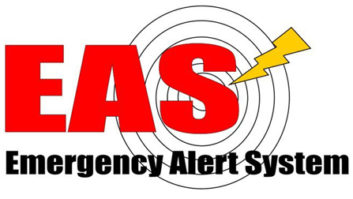The FCC wants to know what you think about possibly modifying the Emergency Alert System to provide “persistent alerts” in extreme emergencies, and how such alerts might work on radio stations and other audio platforms.
Providing persistent alerts is one of several recommendations that were made to the commission by FEMA for improvements to EAS.
FEMA’s recommendations are in addition to alerting changes recently adopted by the commission in June. At that time the FCC issued a further notice of proposed rulemaking to explore FEMA’s ideas.
In addition to persistent alerts, FEMA thinks the FCC should should rename certain EAS terms like EAN and PEP to help public awareness.
The deadlines to comment on the proposed changes have now been set. Comments in PS Docket 15-94 are due Oct. 19, with replies due Nov. 18.
Persistent alerts
A big part of FEMA’s recommendations involves “persistent alerts.” FEMA thinks EAS should be modified to support “persistent display of alert information and/or persistent notification for emergencies that require immediate public protective actions to mitigate loss of life.”
Such alerts would persist on EAS until the alert time has expired or the alert is cancelled by the originator. Merely repeating an EAS message, FEMA says, does not address problems like those that came up in the false missile alert situation in Hawaii. It believes alert information should persist so people can “receive, review and collaborate, whenever they ‘tune in,’ with emergency information received previously from another emergency alert information source.”
The FCC is asking for comments on questions like the technical feasibility of assigning “persistence” to state and local alerts; what kinds of events would qualify; what changes would be required to EAS devices; and whether stations and others who carry state and local alerts on a voluntary basis would agree to carry persistent alerts.
One can envision a persistent alert remaining visible on a video platform, but the FCC also wonders what “persistent” would mean for radio stations and satellite radio, as wall as what role “smart” devices might play for alerts carried by ATSC 3.0 and HD Radio technologies.
Other recommendations
FEMA also thinks the FCC should modify the definition for the EAN event code from “Emergency Action Notification (National Only)” to “Emergency Alert, National,” or replace the EAN event code entirely with a new one called “NEM” for “National Emergency Message.” FEMA thinks “Emergency Action Notification” has no meaning to most people and may create confusion.
FEMA further thinks the FCC should change the EAS originator code for the Primary Entry Point System from “PEP” to “NAT,” which would stand for “National Authority.”
It notes that PEPs — radio stations that are the primary source of initial broadcast for a presidential alert — are not originators. It said using PEP as an originator code currently requires EAS video participants to scroll a message that begins with “The Primary Entry Point System has issued …” which FEMA says means nothing to the public and again could create confusion.
And probably least controversial is a recommendation from FEMA to delete the term “National Information Center” in FCC rules because there is no longer a National Information Center (NIC) in federal and national emergency response plans.





